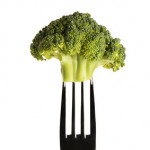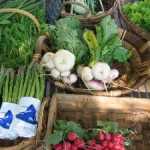These freezer essentials will help you with your weekly meal prep as well as last minute meals that you need to get on the table fast.
Bagged frozen vegetables, like mixed peppers, broccoli, and spinach.
Bagged frozen fruit, like blueberries, mangos, bananas, and strawberries.
Bagged frozen pastas, like tortellini and ravioli.
Frozen waffles and pancakes.
Frozen potatoes, like tots, fries, and breakfast potatoes.
Rice and prepared side dishes.
Pre-made dough, pie crusts, and breads.
Frozen foods are not limited to frozen dinners. You can stock your freezer with healthier ingredients to make putting dinner together easy. There are endless possibilities with what you can make with frozen ingredients. As always, be creative and “work with what you got!”
“Work With What You Got!”
©Tiny New York Kitchen © 2020 All Rights Reserved
I grew up in the Midwest where it was considered a mortal sin to waste food. The motto was “waste nothing and make the most of every ingredient.” Here are some ways for you and your family to make the most of ingredients that otherwise may make their way into the trash bin.
Stewed Fruit does double duty as a topping for pancakes, waffles and ice cream while giving you a serving of fruit. Get started with apples and dried fruits.
Super Stems. Don’t waste the nutrients in stems of greens like collards and kale, or vegetables like broccoli and cauliflower. Use them in longer cooking soups and stews.
Save The Soft. Baked desserts are a great way to use up slightly overripe fruit.
Use It, Don’t Lose It. When you by a special ingredient for a recipe, don’t waste what’s left. Get creative and add them to some of your favorite recipes.
Make Soup with leftovers. Vegetables, grains, and meats make wonderful soups. If you don’t have time to make soup right away, freeze the leftovers until you have a good cooking day. Don’t forget to label and date what you’re freezing for later.
“Work With What You Got!”
© Victoria Hart Glavin Tiny New York Kitchen © 2017 All Rights Reserved
Cauliflower
Whether roasted, mashed, raw or added to pasta dishes, there’s something so comforting about cauliflower’s mild, creamy flavor. Plus, it’s one of the most nutritious vegetables around. What’s not to love?
Cauliflower is a member of the cruciferous family, along with broccoli, cabbage, and kale. These vegetables are an important part of a heart-healthy lifestyle, high in nutrients and fiber and very low in calories.
It’s easier than you might think to separate a whole cauliflower into florets, but if you’re really pressed for time, take advantage of prepared fresh or frozen cauliflower.
To prep cauliflower you will need to first remove the cauliflower’s leaves and cut out the core. Then break into evenly sized florets, cutting any very large ones. Add to a pot of boiling salted water and cook for about 5 minutes. Drain thoroughly. Rinse with cold water if you plan on using it later.
Cauliflower works great as a replacement for higher starch foods like rice, couscous, and potatoes. Steam and mash it to replace potatoes or pulse it in a food processor to create cauliflower “rice” that can be sautéed or steamed and served with curry or chili.
“Work With What You Got!”
© Victoria Hart Glavin Tiny New York Kitchen © 2015 All Rights Reserved
Broccoli
Broccoli is a plant in the cabbage family with tight heads of green, purple, or white flower buds that are cooked and eaten as a vegetable. Broccoli comes from the Latin brachium, “strong arm/strong branch,” and comes from a reference to its shape. Broccoli is the Italian plural of broccoli, “cabbage sprout/head,” and literally means “little shoots.”
When shopping for broccoli look for heads that are dark green or purplish and tightly clustered. The stalks should be fresh looking and not tough or woody.
Refrigerate broccoli for up to five days in a perforated bag. Broccoli can be blanched and frozen for up to 1 year.
To remove dirt simply soak a head of broccoli upside down in a bowl of cold water for 20 minutes. Cut or peel off any stalk parts that are tough. Cut into spears. Broccoli can be precooked by blanching or parboiling.
Eat more broccoli!
Work With What You Got!”
© Victoria Hart Glavin Tiny New York Kitchen
 Pack Your Omelet Full Of Goodness
Pack Your Omelet Full Of Goodness
Omelets are one of those dishes that you can have for breakfast, lunch or dinner. The versatile omelet is low in calories too especially if you start with one egg and two egg whites (about 100 calories). Add the fillings of your choice and you have a protein packed meal that will satisfy your hunger.
Cheese Choices
Choose 1/4 cup of one of these cheese for your omelet.
Shredded Swiss
Shredded Cheddar
Crumbled Feta
Vegetables
Choose as many vegetables as you want because they are full of fiber and low in calories.
Chopped Broccoli
Sliced Mushrooms
Chopped Tomatoes
Proteins
Choose1/4 cup of these delicious proteins.
Smoked Salmon
Turkey Bacon
Ham
Optional
Choose one of these for a total treat.
Sautéed Potatoes
Avocado
Crème Fraiche

“Food, one assumes, provides nourishment; but Americans eat it fully aware that small amounts of poison have been added to improve its appearance and delay its putrefaction.” – John Cage
There has been quite a bit of controversy these days about eating organic. Recent studies state that it really doesn’t matter if you eat organic foods or not. When something is labeled organic, it usually means that a farm has not used pesticides and has taken considerable care to avoid any cross-contamination. Producing organic food undoubtedly costs more money which is passed on to the consumer. Buying organic tends to be quite a bit more expensive than buying non-organic.
Honestly, I don’t care what the studies are saying about eating organic versus eating non-organic. I would rather not put pesticides into my body as well as wanting to support farmers and food companies that are not using pesticides. I love going to farmers’ markets during the spring, summer and fall and when I am shopping in the grocery store I am willing to pay a bit more for organic food.
If you have decided not to buy organic here is a list of foods that have found to be the most and least contaminated.
Most Contaminated
Apples
Bell Peppers
Celery
Cherries
Grapes
Lettuce
Nectarines
Peaches
Pears
Potatoes
Spinach
Strawberries
Least Contaminated
Asparagus
Avocados
Bananas
Broccoli
Cabbage
Corn
Kiwis
Mangos
Onions
Papayas
Peas
Pineapples











